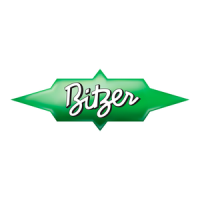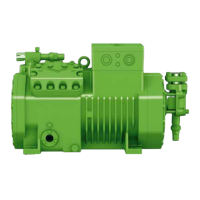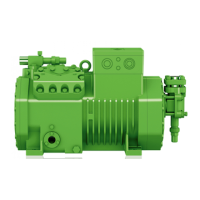16
Connections are according to the
wiring diagram. For further detlais see
Technical Information KT-150.
CIC-System
To maintain the thermal application
limits with R22 low temperature oper-
ation. For technical description and
instructions for fitting and electrical
connections see Technical Information
KT-130.
Attention!
Possible mechanical damage of
the compressor!
Do not operate CIC-system and
capacity control simultaneously!
5 Commissioning
The compressor is already thoroughly
dehydrated, tested for leaks and
under pressure with holding charge
(N
2
).
Attention!
Test the strength pressure and
the tightness of the entire plant
preferably with dry nitrogen (N
2
).
Compressor must be put out of
circuit when using dried air –
keep the shut-off valves closed.
Danger!
By no means the compressor
may be pressure tested with
oxygen or other industrtial
gases!
Warning!
Never add refrigerant to the test
gas (N
2
or air) – e. g. as leak
indicator.
Critical shift of the refrigerant
ignition limit with high pressure
possible!
Environmental pollution with
leakage or when deflating!
!
!
!
!
!
Raccordement conformément au schéma
de principe. Pour des details supplémen-
taires voir Information Technique KT-150.
Système CIC
Sert à délimiter la plage de fonctionne-
ment du point de vue thermique en cas
d'emploi du R22 en basses températures.
Description technique et indications pour
le montage et le raccordement électrique,
voir information technique KT-130.
Attention !
Possible défaut mécanique au com-
presseur !
Ne pas opérer le système CIC et la
régulation de puissance simultané-
ment !
5 Mise en service
Le compresseur est soigneusement
séché en usine, son étanchéité est
contrôlée et il est rempli avec un gaz de
protection (N
2
).
Attention !
Essayer la résistance à la pression
et l'étanchéité de toute l’installation
préféremment avec l'azote sec (N
2
).
Compresseur doit être remis hors
du circuit quand l'air sec est vitilisé.
– maintenir les vannes d’arrêt fer-
mées.
Danger !
Ne faire, en aucun cas, les essais
de pression sur le compresseur
avec de l'oxygène ou tout autre gaz
technique !
Avertissement !
Ne jamais ajouter fluide frigorigène
au gaz d'essai (N
2
ou air) – par ex.
comme indicateur de fuite.
Décalage critique de la limite d’in-
flammabilité du fluide frigorigène
possible, en cas de surpression !
Pollution de l'environnement en
cas de fuite ou d’évacuation du
système !
!
!
!
!
!
Anschluss gemäß Prinzipschaltbild.
Weitere Details siehe Technische
Information KT-150.
CIC-System
dient zur Absicherung der thermischen
Anwendungsgrenzen bei R22-Tiefküh-
lung. Technische Beschreibung und
Hinweise zu Montage und elektri-
schem Anschluss siehe Technische
Information KT-130.
Achtung!
Mechanischer Schaden am
Verdichter möglich!
CIC-System und Leistungsrege-
lung nicht gleichzeitig betreiben!
5 In Betrieb nehmen
Der Verdichter ist ab Werk sorgfältig
getrocknet, auf Dichtheit geprüft und
mit Schutzgas (N
2
) befüllt.
Achtung!
Druckfestigkeit und Dichtheit der
gesamten Anlage bevorzugt mit
getrockneten Stickstoff (N
2
) prü-
fen.
Bei Verwendung von getrockne-
ter Luft Verdichter aus dem
Kreislauf nehmen –
Absperrventile unbedingt
geschlossen halten.
Gefahr!
Verdichter darf keinesfalls mit
Sauerstoff oder anderen techni-
schen Gasen abgepresst wer-
den!
Warnung!
Dem Prüfmedium (N
2
oder Luft)
keinesfalls Kältemittel beimi-
schen – z. B. als Leck-Indikator.
Kritische Verschiebung der
Kältemittel-Zündgrenze bei
Überdruck möglich!
Umweltbelastung bei Leckage
und beim Abblasen!
!
!
!
!
!

